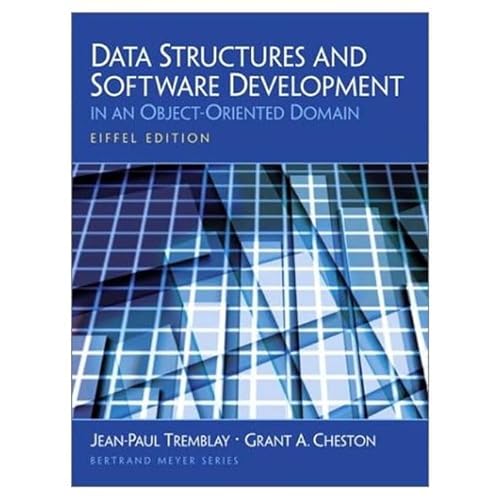Data Structures and Software Development in an Object-Oriented Domain (Object and Component Technology Series) - Hardcover

Synopsis
(Pearson Education) A textbook designed for undergraduate computer science students. Provides an introduction to data structures using object-oriented analysis and design. The CD-ROM contains an Eiffel compiler and development environment, with several other tools for use with the text. DLC: Object-oriented programming (Computer science).
"synopsis" may belong to another edition of this title.
From the Back Cover
FEATURES
- Use of a subset of the UML—Shows how to use UML for analysis and modeling.
- CD-ROM included—CD contains an Eiffel compiler and development environment, all the code for the text, and the data structures library.
- Modeling of the Problem Domain—Absent in other texts, this book models the problem domain that an object-oriented project must begin with.
- Two case studies—Illustrates the steps followed in an object-oriented development process for the analysis and design of non-trivial systems.
- Extensive Data Structures Library—Consists of the standard data structures, including lists, stacks, queues, trees, balanced trees, graphs, and files.
- Extensive Reference for the Eiffel language—A full-featured object-oriented language, Eiffel, specifically developed for large object-oriented systems.
"About this title" may belong to another edition of this title.
Search results for Data Structures and Software Development in an Object-Orient...
Data Structures and Software Development in an Object-Oriented Domain (Object and Component Technology Series)
Seller: HPB-Red, Dallas, TX, U.S.A.
Hardcover. Condition: Good. Connecting readers with great books since 1972! Used textbooks may not include companion materials such as access codes, etc. May have some wear or writing/highlighting. We ship orders daily and Customer Service is our top priority! Seller Inventory # S_393011903
Data Structures and Software Development in an Object-Oriented Domain (Object and Component Technology Series)
Seller: Phatpocket Limited, Waltham Abbey, HERTS, United Kingdom
Condition: Acceptable. Used - Acceptable. Your purchase helps support Sri Lankan Children's Charity 'The Rainbow Centre'. Ex-library with wear and barcode page may have been removed. Our donations to The Rainbow Centre have helped provide an education and a safe haven to hundreds of children who live in appalling conditions. Seller Inventory # Z1-V-007-01496
Buy Used
Ships from United Kingdom to U.S.A.
Quantity: 1 available
Data Structures and Software Development in an Object Oriented Domain (Object and Component Technology Series)
Seller: Brit Books, Milton Keynes, United Kingdom
Hardcover. Condition: Used; Very Good. ***Simply Brit*** Welcome to our online used book store, where affordability meets great quality. Dive into a world of captivating reads without breaking the bank. We take pride in offering a wide selection of used books, from classics to hidden gems, ensuring there is something for every literary palate. All orders are shipped within 24 hours and our lightning fast-delivery within 48 hours coupled with our prompt customer service ensures a smooth journey from ordering to delivery. Discover the joy of reading with us, your trusted source for affordable books that do not compromise on quality. Seller Inventory # 3764474
Buy Used
Ships from United Kingdom to U.S.A.
Quantity: 1 available
